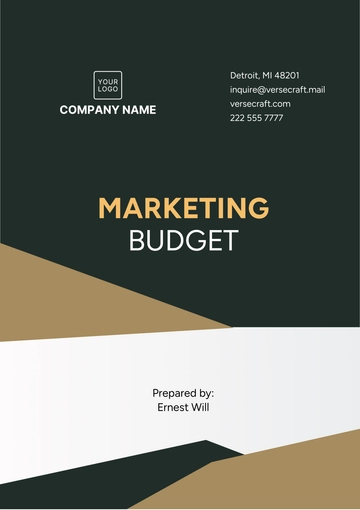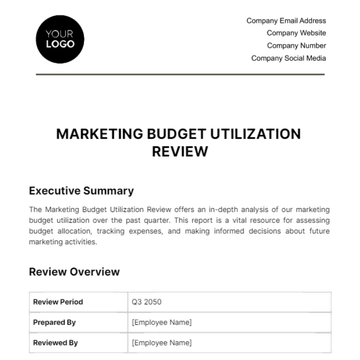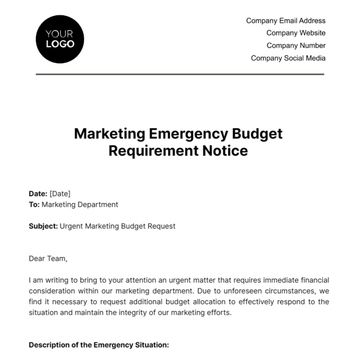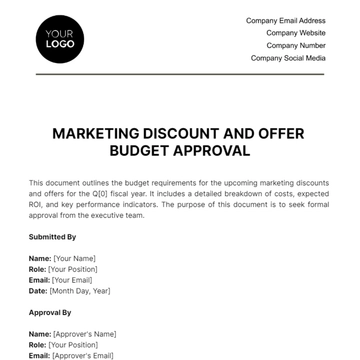Free Marketing Annual Budget Format

I. Introduction
The Marketing Annual Budget is a crucial financial document that outlines the projected marketing expenses and allocations for the upcoming fiscal year. It serves as a blueprint for managing marketing resources efficiently, ensuring that all marketing activities align with the strategic goals of [Your Company Name]. This budget is designed to provide a comprehensive overview of expected costs, including advertising, promotions, events, digital marketing, and other key areas essential for driving growth and brand awareness.
II. Objectives of the Marketing Annual Budget
A. Financial Planning and Control
The primary objective of the Marketing Annual Budget is to provide a detailed financial plan that guides the allocation of resources across various marketing initiatives. This ensures that the marketing department operates within its financial means, avoiding overspending and enabling better financial control.
B. Resource Allocation
The budget helps prioritize marketing activities based on their potential return on investment (ROI). By identifying key areas of focus, [Your Company Name] can allocate resources effectively to the most impactful initiatives.
C. Performance Measurement
The budget serves as a benchmark for evaluating the performance of marketing campaigns and activities. By comparing actual expenditures against the budget, [Your Company Name] can assess the effectiveness of its marketing strategies and make data-driven decisions.
III. Marketing Budget Breakdown
The following table outlines the estimated costs for each marketing activity planned for the upcoming fiscal year. The budget is divided into key categories, with each section detailing the associated costs.
Table 1: Marketing Annual Budget Breakdown
Category | Description | Estimated Cost (USD) | Percentage of Total Budget |
|---|---|---|---|
1. Advertising | |||
1.1. Digital Advertising | Includes PPC, social media ads, etc. | $150,000 | 25% |
1.2. Print Advertising | Magazines, newspapers, etc. | $50,000 | 8% |
2. Content Marketing | |||
2.1. Content Creation | Blogs, videos, infographics, etc. | $70,000 | 12% |
2.2. SEO and SEM | Search engine optimization and marketing | $40,000 | 7% |
3. Events and Sponsorship | |||
3.1. Trade Shows | Booth rental, materials, travel | $60,000 | 10% |
3.2. Sponsorships | Sponsoring industry events and conferences | $30,000 | 5% |
4. Public Relations | |||
4.1. Media Relations | Press releases, media outreach | $20,000 | 3% |
4.2. Influencer Marketing | Collaborations with influencers | $40,000 | 7% |
5. Market Research | |||
5.1. Surveys and Analytics | Consumer surveys, data analysis | $25,000 | 4% |
6. Digital Marketing | |||
6.1. Email Marketing | Email campaigns, newsletters | $15,000 | 3% |
6.2. Social Media Marketing | Organic and paid social media campaigns | $45,000 | 8% |
7. Miscellaneous | |||
7.1. Contingency Fund | Unforeseen expenses | $30,000 | 5% |
Total Estimated Budget | $575,000 | 100% |
IV. Budget Allocation Strategy
A. Advertising
The largest portion of the budget is allocated to advertising, with a focus on digital channels. Digital advertising, which includes pay-per-click (PPC) campaigns and social media ads, accounts for 25% of the total budget. This allocation reflects the increasing importance of digital platforms in reaching target audiences. Print advertising, while still relevant for certain demographics, receives a smaller allocation, representing 8% of the total budget.
B. Content Marketing
Content marketing is a vital component of [Your Company Name]’s strategy, receiving 19% of the total budget. This includes content creation across various formats (12%) and search engine optimization and marketing efforts (7%) to ensure that content reaches the intended audience.
C. Events and Sponsorships
Events and sponsorships are allocated 15% of the total budget. Trade shows, which offer opportunities for direct engagement with potential customers, are a key focus, while sponsorships help enhance brand visibility within the industry.
D. Public Relations
Public relations, including media relations and influencer marketing, receives 10% of the total budget. This allocation is intended to enhance [Your Company Name]’s brand reputation and increase its reach through credible third-party endorsements.
E. Market Research
Market research is allocated 4% of the total budget to ensure that [Your Company Name] remains informed about consumer needs, preferences, and market trends. This data is critical for making informed marketing decisions.
F. Digital Marketing
Digital marketing initiatives, including email marketing (3%) and social media marketing (8%), together receive 11% of the total budget. These channels are essential for maintaining ongoing engagement with existing customers and attracting new ones.
G. Miscellaneous and Contingency
A contingency fund, accounting for 5% of the total budget, is reserved for unforeseen expenses that may arise during the year. This ensures that [Your Company Name] can adapt to unexpected challenges without compromising its marketing efforts.
- 100% Customizable, free editor
- Access 1 Million+ Templates, photo’s & graphics
- Download or share as a template
- Click and replace photos, graphics, text, backgrounds
- Resize, crop, AI write & more
- Access advanced editor
Organize your yearly marketing expenses with the Marketing Annual Budget Format Template from Template.net. This editable and customizable template offers a comprehensive structure for planning and monitoring annual marketing budgets. Use our Ai Editor Tool to adjust the format, ensuring all marketing activities are financially planned and controlled throughout the year.
You may also like
- Budget Sheet
- Personal Budget
- Non Profit Budget
- Monthly Budget
- Project Budget
- HR Budget
- Company Budget
- Home Budget
- Weekly Budget
- College Budget
- Business Budget
- Construction Budget
- Small Business Budget
- Hotel Budget
- Annual Budget
- Home Renovation Budget
- Household Budget
- Student Budget
- Grocery Budget
- Marketing Budget
- Corporate Budget
- Startup Budget
- Manufacturing Budget
- Church Budget
- University Budget
- Annual Budget Plan
- Event Budget
- Operating Budget
- Travel Budget
- Food Budget
- IT and Software Budget
- School Budget
- Real Estate Budget
- Sales Budget
- Conference Budget
- Budget Finance
- Freelancer Budget
- Budget Advertising





























